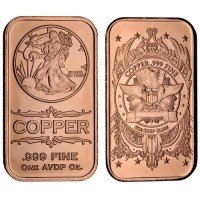

Bullion is a popular form of investment, particularly in recent years. Due to market volatility in the last decade, many investors are turning to precious metals to protect their financial portfolios from inflation and other potential financial catastrophes.
But in addition to investment reasons, there are other good motivations for purchasing bullion, particularly bullion bars. For investors who are also collectors, a form of bullion called “art bars” is an attractive way to simultaneously secure their investments and add interest to their collections.
An art bar is a bullion bar that has artwork engraved on the front, back or sometime even both sides. Sometimes these art bars are created as limited edition collections. Often they are produced to commemorate an important historical event or anniversary, such as the United States Bicentennial in 1976. It is also fairly common to see a bar that is meant to reflect a popular coin design such as the Morgan dollar.
However, sometimes these bars are minted with more unconventional themes. These themes can range anywhere from a patriotic scene to a display of the four seasons. Some of the more interesting designs that have been minted include UFOs, Haley’s Comet, and a large gorilla.
Art bars are becoming increasingly fashionable, as well. In 2012, famous fashion and fragrance designer Jean Paul Gaultier, in conjunction with a Dallas-based bullion manufacturer, released a 24 karat one-ounce gold bar just in time for Valentine’s Day. The bars were engraved with golden rays emanating from behind a heart sporting Gaultier’s iconic nautical stripes with the designer’s name scrolled across the front.
Art bars are popular with collectors because they are so unique. They have a sort of “antique” feel to them that lends a special quality to any collection. Oftentimes, collectors seek to gather all the bars in a set.
Art bars are also given as gifts – not only are they a valuable addition to an investment portfolio, but because of their unique designs, they can be very personal to the recipient. For example, a bar depicting a favorite historical figure would make a thoughtful gift for a graduate in History. And who wouldn’t love a gold bar with an engraved heart for Valentine’s Day?
Art bars can have historical and cultural significance. Often the designs signify an important event, historical figure or cultural phenomenon that is unique to the time period or place where it was produced. They are also a popular investment for those who want something more unique in their portfolio or for collectors who view them as an artistic investment.
Art bars sell for more than plain bullion due to their distinctiveness. Their price is generally based on a number of factors: the content, weight and purity of the metal, the rarity and condition of the bar, and the quality of the artwork.
It is hard to predict the exact resale value of an art bar, because the price depends largely on what collectors are looking for at a given time and what a buyer is willing to pay. Certain designs are more popular than others for a variety of reasons. Because there is often an emotional element involved in their purchase, there is no definitive way to predict the selling price of the bars.
However, an investor can expect to sell an art bar for more than he or she would get for a plain bullion bar. For example, because his brand was attached to it, Jean Paul Gaultier’s one ounce Valentine’s Day bars sold for $1,826, which was 10 percent higher than the going price for a regular one-ounce bar of gold.
Art bars can be produced in any form of bullion bars, including gold, silver, copper, platinum, palladium, etc., but the most popular are silver, gold and platinum. Art bars are produced by both large and small bullion manufacturers. There are several different ways in which bullion bars are made. Before the advent of modern manufacturing, bars were hand poured into molds one by one. This was a long and painstaking process. While some manufacturers still use this method, most use modern machinery in a process called minting, in which large numbers of bars are produced en masse and then stamped with the manufacturer’s name and a distinctive serial number.
In the case of art bars, the bullion is also stamped or engraved with a particular design. Many bullion manufacturers are able and willing to produce both large and small orders of custom art bars for their clients.
Art bars are a beautiful and unique addition to any investment portfolio or collection. Their timelessness and value will continue to bring not only financial security, but enjoyment and delight to investors and collectors for years to come.